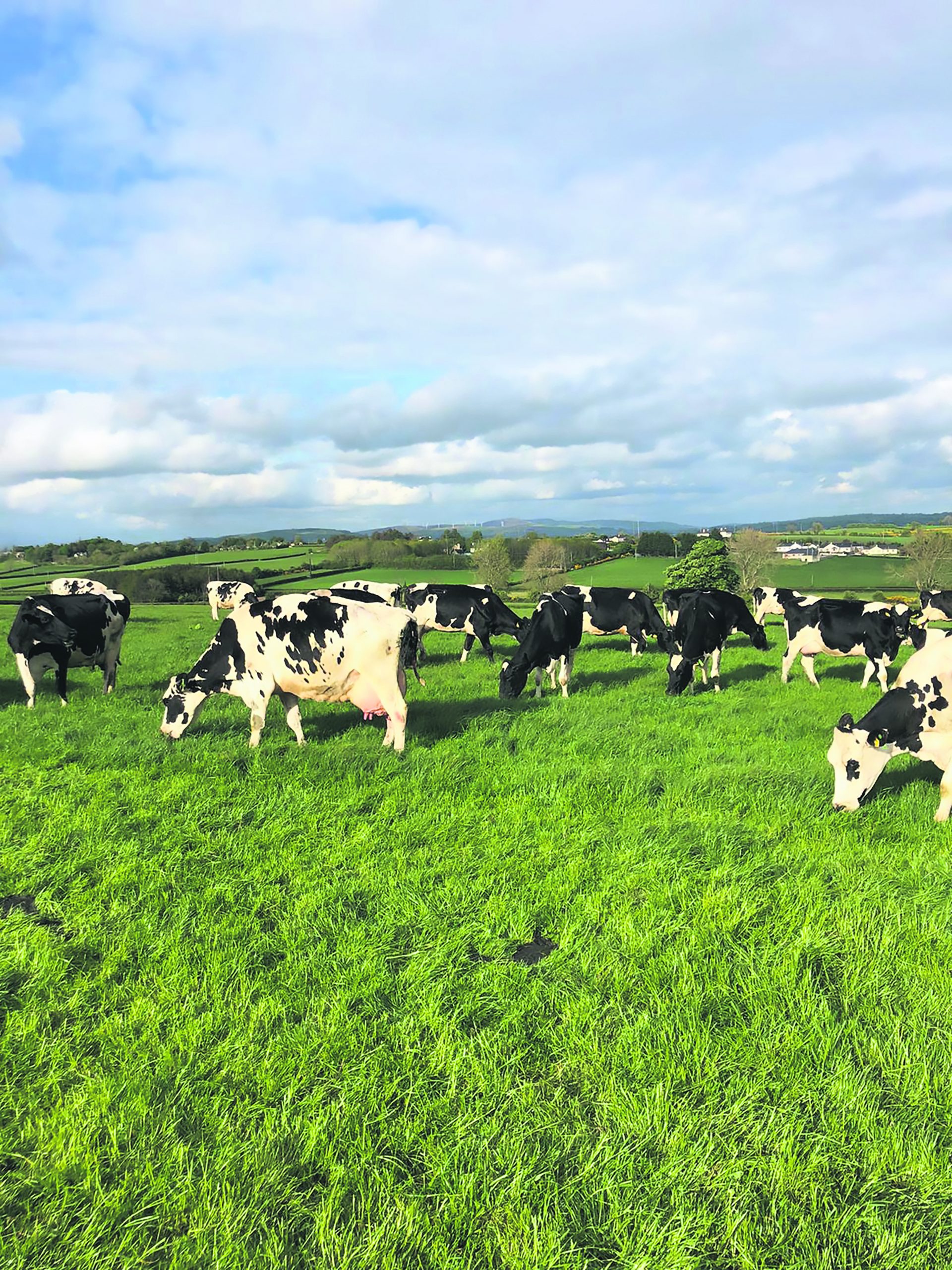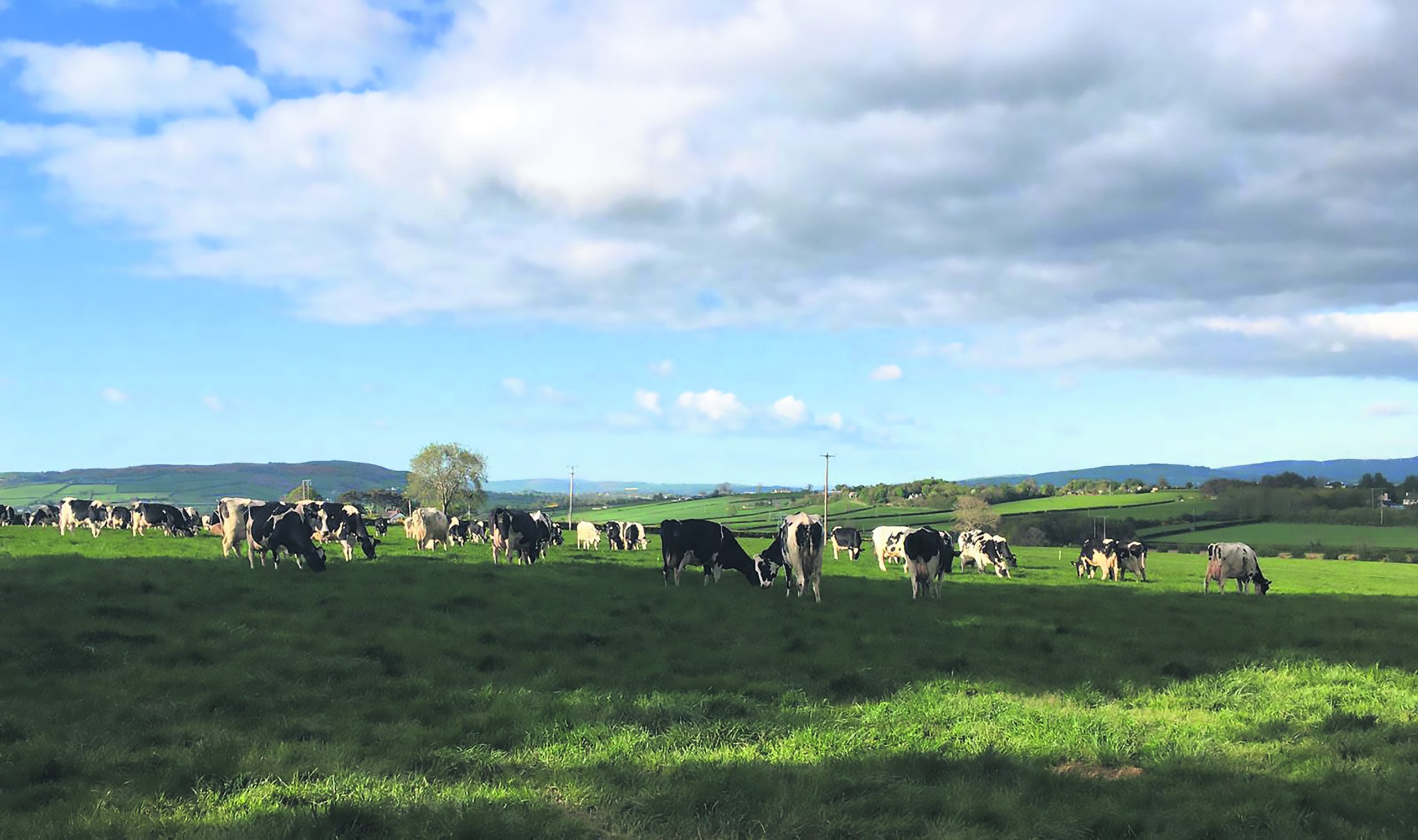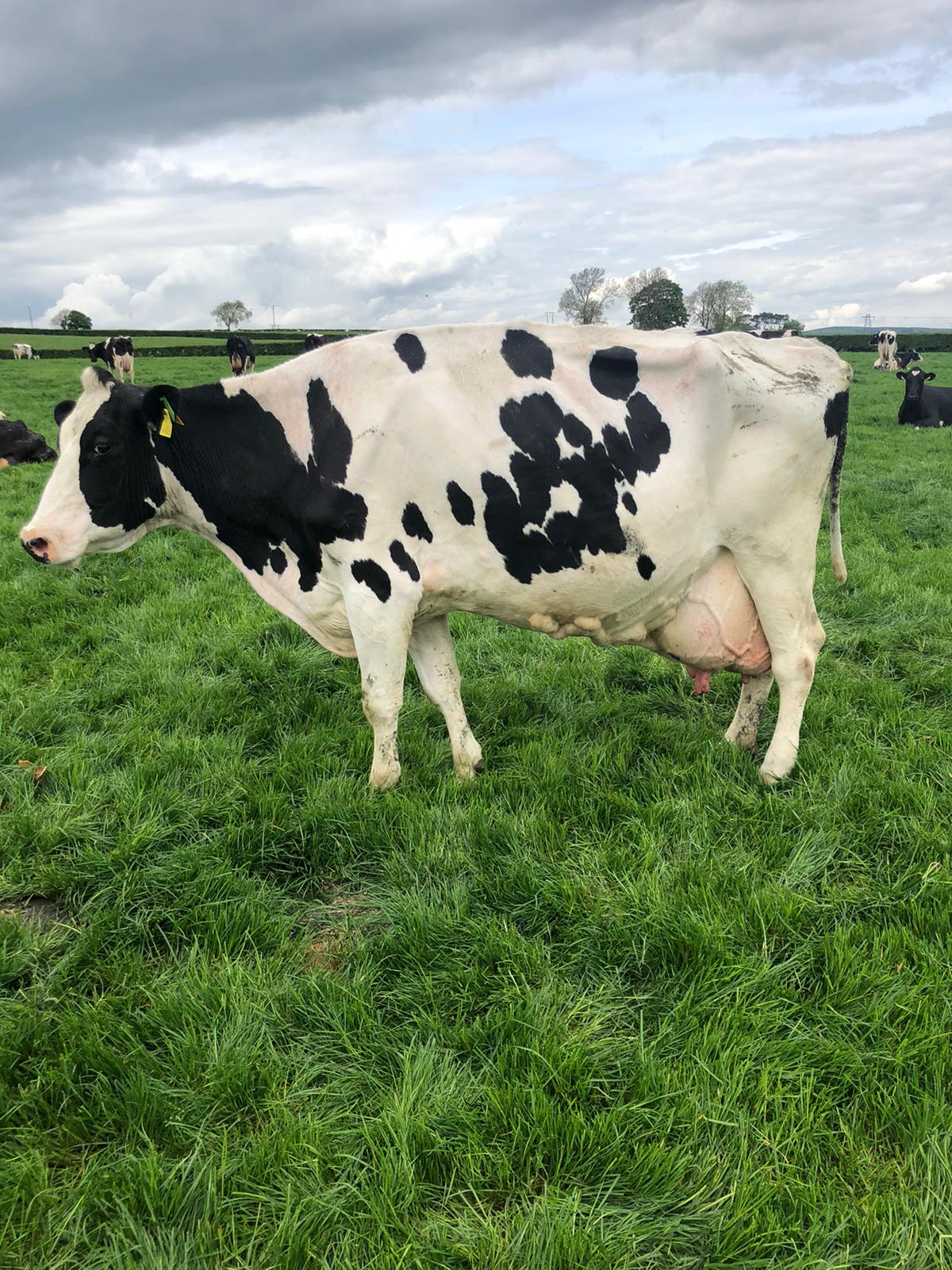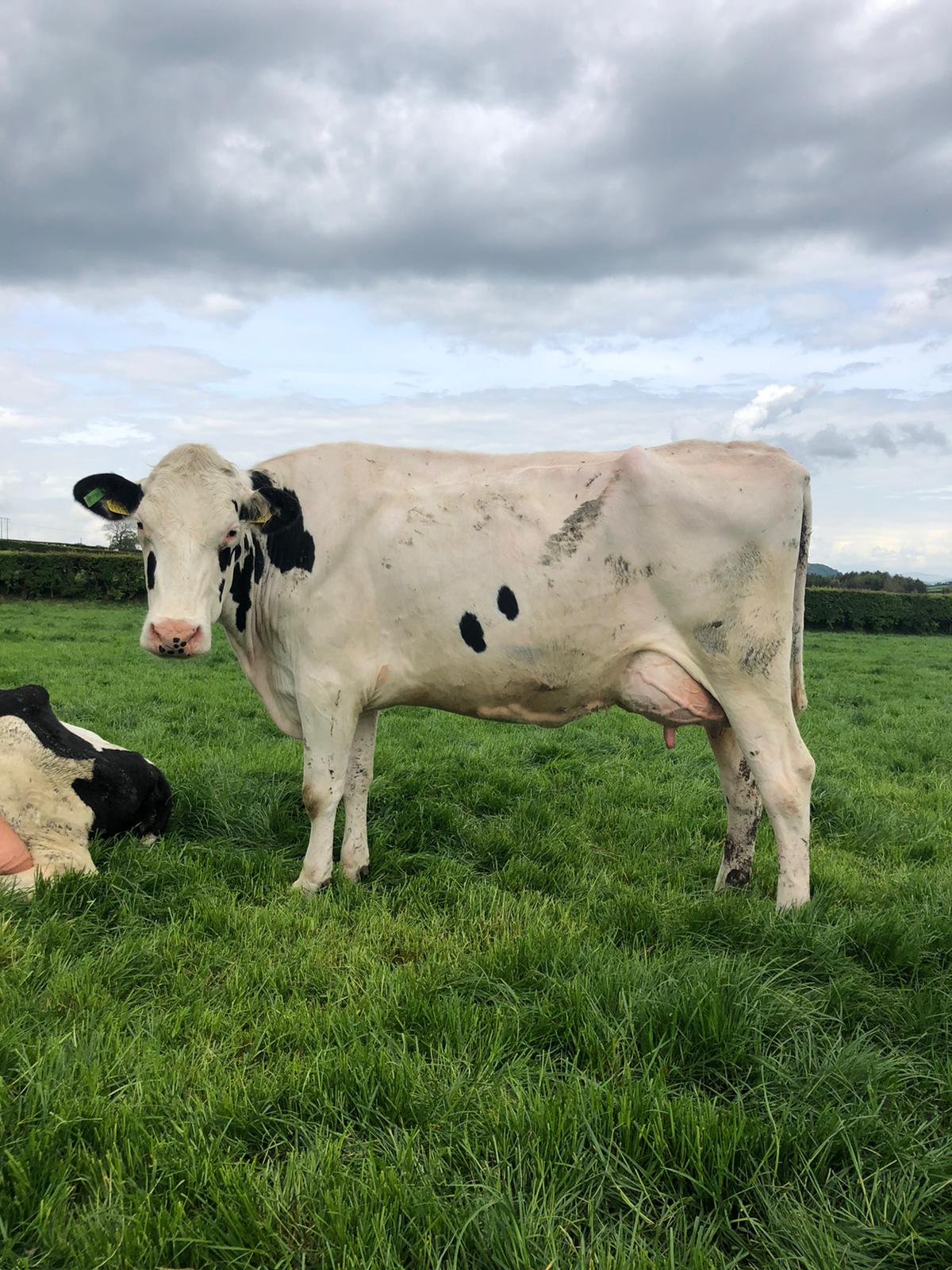Monien Holstein Friesian herd – Alan and David Macbeth & families, Ballindrait, Lifford, Co. Donegal.
Going against the trend – more milk from less cows
An IHFA Donegal Friesian Breeders Club herd profile
Donegal brothers Alan and David Macbeth are currently milking 125 pedigree registered Holstein Friesian cows on the family farm located one mile outside Lifford on the Donegal-Tyrone border. The herd ranks in the top 8% of all co-op suppliers for litres/cow/day, a ranking of five-star performance in the co-op performance report for 2019. In terms of fat & protein kgs per cow, the herd ranks 20% ahead of the co-op average, another five-star performance attainment.
From a peak herd size of 160 cows in 2003, cow numbers have been purposely reduced gradually in a strategic alternative approach regards herd management. Focusing on quality instead of quantity has resulted in efficiency gains. As part of this approach to increase quality IHFA Classification service was adopted, beginning in 2013. Milk production per cow increased from 7,000kgs/cow to over 8,000kgs/cow. With fewer cows, herd yield increased by 2.5% last year versus the previous year.
2019 milk production output for the herd was 0.97 million kilos milk, 67,000kgs milk solids. Current milk recorded average production is 36 litres/cow, 3.75% fat, 3.30% protein. Milk solids production per cow last year averaged 537kgs. Herd calving pattern is 95% spring. Fertility is a strong point with an overall herd calving interval of 368 days. There are 30 cows scored VG/EX on IHFA classification scoring of conformation. The close correlation in relationship between IHFA classification scoring and longevity is expressed in this Donegal herd where of the six cows of 7th lactation or greater, five are scored to VG/EX standard.
Discussing cow type, Alan says
“Firstly, cow type, or conformation, is very important as the functional working traits of a cow directly influences her overall productivity. It goes a long way to shaping her destiny as to longevity. With the economic cost and opportunity cost of rearing calves through to calved-in heifers, the importance of her genetic make-up and her overall functionality is vital.
“The breeding emphasis for the herd is medium size cows having good overall balance. Feet and legs rank highly in importance and I also like to see good dairy character. The importance and value of functionality and milk production ability is very apparent at auctions and sales.
“Having started to classify the herd seven years ago, I have gained so much benefit from the service. I have picked up very useful and insightful information from every classification inspection visit. In the past I suppose I did have a view that my cows weren’t good enough to benefit from classification. Maybe at times the breeder under-estimates his/her own herd. The classifier, with an objective viewpoint and linear method of analysis, imparts a highly independent assessment. It’s another helpful tool in the overall tool box to help you achieve standards. Also, it is useful for marketing – it helps put you herd out there and helps raise herd profile. From my experience I certainly would encourage all dairy farmers to classify their herds”. 40 replacement heifers are calved-in annually with surplus heifers offered for sale. Alan comments that, with the farm’s close proximity to Northern Ireland, it is an advantage to have this steady market with high demand for quality milking stock as an outlet so close to home.
Every effort is made to utilise grazed grass to the maximum. In normal years where weather conditions allow, cows are out to grass by day in late March and grazing full-time from April 10th onwards. If autumn conditions allow, the grazing year can often extend into mid-October before housing.
Working together closely, the brothers farm 220 acres in total. Alan and his wife Cheryl have two children – Sarah (aged 12) and Callum (aged 10). David and his wife Linda also have two children – Emma (aged 15) and Sam (aged 13). The brothers’ parents William and Audrey established a very successful family farm over the years and handed a prosperous legacy onto the next generation.Alan says “I developed a strong interest and appreciation of pedigrees from a young age thanks to my uncle Willie Torrens. Herdbook registrations and pedigree bloodlines add a depth of added interest and enjoyment to what we do as dairy farmers. The pedigree cert is an assurance of your own herd performance and status. Herds may be similar but of course each herd is unique in its make-up and management. The pedigree cert, with its data capture combining ancestry, genetics and recorded performance is a reflection of the breeder.
“I seek out the best breeding material that I can when it comes to breeding decisions. Through a combination of grading up and the choice purchase of pedigree stock over the years, the end result was pedigree status across the herd. Recent cow family additions to the herd includes Mountfarna Stonewall Ruth, bred from Mountfarna Crew Ruth EX93 4E, an IHFA Diamond Award recipient tracing back to Shopland Edleet Ruth 6 EX and Monamore Charity 12 VG86, tracing back to Brookview Tony Charity EX97. Successful stock bulls used in the past include Majestic Fellani EX92, Derrydoragh Relief EX92 (bred from an EX95 dam).
An overview of the cow families of the Monien herd includes;
Derrydorragh Leif Dixie EX93 4E
- Purchased as a fresh heifer this Leif daughter has proven to be a sound acquisition for the Monien herd.
- 7th lactation with an average milk recorded production of over 12,000kgs per lactation.
Monien Jag Pansy 2519
- In her 8th lactation with a consistent, regular calving interval pattern annually.
- 7th lactation yield 9,635kgs milk, 671kgs milk solids, 3.63% fat, 3.35% protein.
- Her grand dam is Monien Black Pansy EX with a lifetime longevity of eleven lactations.
Monien Barbara 28 EX
- Now in her 7th lactation having recorded three lactations over 8,000kgs milk/lactation to date.
- Calved as a heifer on April 1st 2014, she calved-in on her 7th lactation March 21st this year, gaining time.
Monien Kathleen 104 VG88
- Four consecutive lactations over 9,000kgs milk in her previous four lactations.
- Currently in her 8th lactation – she embodies great longevity and production performance.
- Her dam is Monien Kathleen 101 EX90 2E with a lifetime longevity of seven lactations.
Monien Nevandy 40 VG88
- 5th lactation yield 9,572kgs milk, 672kgs milk solids, 3.50% fat, 3.52% protein
- Four lactations of 3.50% protein or greater.
Her daughter Monien Nevandy 57 GP81
- 2nd lactation yield 9,009kgs milk, 615kgs milk solids, 3.40% fat, 3.43% protein.
Monien Nevandy 53 GP84
- 2nd lactation yield 8,378kgs milk, 625kgs milk solids, 3.83% fat, 3.62% protein
Monien Kathleen 189 VG87
- 3rd lactation yield 10,797kgs milk, 728kgs milk solids
Monien Jag Mona 2610 VG87
- 4th lactation projected yield 8,844kgs milk, 626kgs milk solids, 3.63% fat, 3.45% protein.
- Calved twice last year – January 8th and again on Christmas day.
Monien Coleen 35 VG87
- 3rd lactation yield 9,793kgs milk, 692kgs milk solids, 3.73% fat, 3.34% protein
- 3rd generation VG
Monien Champion Stella 4 GP84
- 3rd lactation yield 8,244kgs milk, 668kgs milk solids, 4.37% fat, 3.73% protein
Monien Dorothy 56 VG85
- 4th lactation yield 9,041kgs milk, 680kgs milk solids, 3.93% fat, 3.65% protein
Monien Jag Daisy 4 GP82
- 2nd lactation yield 8,034kgs milk, 673kgs milk solids, 4.42% fat, 3.96% protein
- Bred from a VG86 dam, from a home-bred family tracing back to ASR cow Monien Daisy with a lifetime longevity of nine lactations.
Monien Jesleen GP84
- 2nd lactation yield 7,071kgs milk, 600kgs milk solids, 4.45% fat, 4.03% protein
Monien Coleen 27 GP83
- 2nd lactation yield 7,982kgs milk, 586kgs milk solids, 3.84% fat, 3.50% protein
- Bred from a VG88 dam with lifetime longevity of nine lactations.
Monien Relief Casey 3227 VG85
- 2nd lactation yield 8,286kgs milk, 636kgs milk solids, 4.17% fat, 3.50% protein.
- Her dam Monien Genuine Casey 737 VG88 with a 4th lactation yield of 9,594kgs milk, 712kgs milk solids, 3.88% fat, 3.54% protein.
Monamore Fifi 27 VG86
- 3rd lactation yield 7,378kgs milk, 538kgs milk solids, 3.59% fat, 3.70% protein.
Monien Mossie 35 VG85
- 2nd lactation yield 8,382kgs milk, 638kgs milk solids, 4.09% fat, 3.51% protein
Monien Catador 22 VG85
- 1st lactation yield 7,797kgs milk, 541kgs milk solids, 3.45% fat, 3.49% protein.
- The herd’s first home-bred heifer to score VG85 in her first lactation.
The continued quest for on-going herd improvement includes an open-minded approach to new and emerging ideas, tools and technologies. Adopting IHFA classification seven years ago is one example of this open-mind approach and evolution in thinking. The decision to reduce cow numbers with consequent focus on increasing quality is another example. Going against the grain somewhat in terms of the trend in herd size, the upshot of this strategy was improved herd productivity including fertility performance with individual cows positively responding to the effects of more intense herd management and less within-herd competition.
“Don’t be afraid to take difficult decisions from time to time” is Alan’s advice, based on his own experience. He remarks on the wealth of information from reports now available to inform management decisions and thus strive for improvements. These include co-op performance report, dairy herd performance report and the classification inspection report and summary, which is now available to view on-line, presented in the format of graphs.
The quality of the herd and progress achieved recently resulted in being nominated by the Donegal Club to participate in the IHFA National Herds competition last year.
“I was thrilled and humbled to go forward as the club representative last year” says Alan. He also states that he was honoured to have been asked by the club to host a field evening this year. Unfortunately, due to the Covid-19 pandemic, it is likely this event will not go ahead. Nonetheless, whenever the event does get the go-ahead, the Monien herd is sure to attract a lot of interest.
(First published in 2020)






